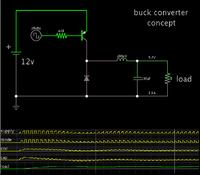bhl777
Full Member level 6

When we analyze the switching regulator, textbooks only mentioned that the switching frequency is much higher than time constant of converter itself. But nowhere mentioned what exactly this time constant is. Could anybody advise what is this?
For example, we have a buck circuit with fsw=400kHz, how can we explain the switching frequency is much faster than natural time constant?
Thanks!
For example, we have a buck circuit with fsw=400kHz, how can we explain the switching frequency is much faster than natural time constant?
Thanks!



